
Every 50 years or so, a star in our Galaxy blows itself apart in a supernova explosion, one of the most violent events in the universe. The force of these explosions produces spectacular light shows. Explosions in past millennia have been bright enough to catch the attention of early astronomers hundreds of years before the telescope had been invented.
Since supernovas are relatively rare events in the Milky Way, they are best studied by combining historical observations with information from today. This cosmic forensic work involves interdisciplinary research by historians and astronomers, and can provide valuable clues about supernovas in our Galaxy in the relatively recent past.
Historical observations were made using optical light, but today the material from the destroyed star can be studied across the full electromagnetic spectrum, including X-ray light. Because material is heated to millions of degrees, the remnants of supernova explosions often glow brightly in X-rays for thousands of years. The Chandra X-ray Observatory images on the front of this poster shows the remnants of historic supernovas that occurred in our galaxy. Eight of the best examples are shown.
Based on the evidence, there is a range of confidence about whether the historical record can be definitively tied to the remnant seen today.
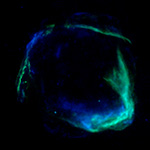
RCW 86, Year: 185 A.D.
As reported in a single Chinese record, the supernova of 185 AD was visible for at least 8 months and reached a brightness com-parable to Mars. Optical, radio, and X-ray emission observed at a location consistent with the Chinese record make RCW 86 the prime candidate for the remnant of SN 185 AD. Combined images from the Chandra (upper left and lower right boxes) and XMM-Newton X-ray observatories show low, medium and high-energy X-rays in red, green, and blue respectively. By studying the amount of X-rays at different energies, and measuring the remnant’s size, scientists now surmise that RCW 86 was created by the explosion of a massive star roughly 2,000 years ago.
Credit: Chandra: NASA/CXC/Univ. of Utrecht/J.Vink et al.;XMM-Newton: ESA/Univ. of Utrecht/J.Vink et al.
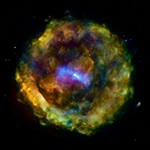
G11.2-0.3, Year: 386 A.D.
The new star of 386 AD was recorded by Chinese observers and was visible for about three months. Although there are several supernova remnants in the vicinity of the reported outburst, G11.2-0.3 is the prime candidate. G11.2-0.3 is a circularly symmetric supernova remnant that contains a dense, rotating dead star at its center (white). In Chandra’s X-ray image, the pulsar and a cigar-shaped cloud of energetic particles, known as a pulsar wind nebula, are predominantly seen as high-energy X-rays (blue). A shell of heated gas from the outer layers of the exploded star surrounds the pulsar and the pulsar wind nebula and emits lower-energy X-rays (represented in green and red).
Credit: NASA/CXC/Eureka Scientific/M.Roberts et al.
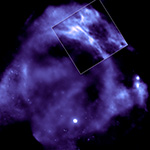
G347.3-0.5, Year 393 A.D.
The supernova of 393 AD was recorded by the Chinese and was visible for about 8 months, reaching the brightness of Jupiter. There are several supernova remnants within this region, so it is difficult to identify the remnant of SN 393 AD with certainty. X-rays from G347.3-0.5 are dominated by radiation from extremely high-energy electrons in a magnetized shell rather than radiation from a hot gas. The remnant, seen by Chandra (inset box) and XMM-Newton, is also a source of very high-energy gamma rays. The bright, point-like source on the lower right in the image (which shows only the upper portion of the entire remnant) is similar to other known neutron stars and indicates that G347.3-0.5 is the remnant of a core-collapse supernova.
Credit: Chandra: NASA/CXC/SAO/P.Slane et al.; XMM-Newton:ESA/RIKEN/J.Hiraga et al.;
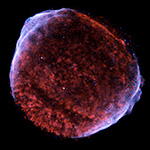
SN 1006, Year: 1006 A.D.
Numerous observers reported that supernova of 1006 AD (now known as SN 1006) attained a brightness greater than the planet Venus, making it the brightest supernova recorded as seen from Earth. A number of lines of evidence — its location well above the Galactic disk, the detection of significant amounts of cool iron gas in its interior, the absence of any evidence for a neutron star, and the implication from the historical record that it remained visible for several years — imply that SN 1006 was the result of the explosion of a white dwarf star. The Chandra image shows X-rays produced by high-energy particles (blue) and multimillion degree gas (red/green).
Credit: NASA/CXC/Rutgers/J.Hughes et al.
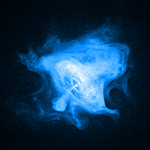
Crab Nebula, Year: 1054 A.D.
The Crab Nebula is the remnant of a supernova observed in 1054 AD. Its brightness was comparable to the planet Venus. The bright nebula, which has been known optically since the early 18th century, is due to the activity of a neutron star (bright white dot in the center of the image) that is rotating 30 times a second and spewing out a blizzard of extremely high-energy particles. Chandra’s image of the Crab Nebula reveals rings and jets of high-energy particles that appear to have been flung outward over great distances from the neutron star. The diameter of the inner ring is about 1,000 times the diameter of our solar system.
Credit: NASA/CXC/ASU/J.Hester et al.
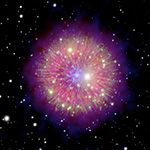
Pa30 / SNR 1181, Year: 1181 A.D.
In the year 1181 a rare supernova explosion appeared in the night sky, staying visible for 185 consecutive days. Historical records show that the supernova looked like a temporary ‘star’ in the constellation Cassiopeia shining as bright as Saturn. Ever since, scientists have tried to find the supernova’s remnant. At first it was thought that this could be the nebula around the pulsar — the dense core of a collapse star — named 3C58. However closer investigations revealed that the 3C58 pulsar is older than supernova 1181. In the last decade, a new contender was discovered; Pa 30 is a nearly circular nebula with a central star in the constellation Cassiopeia. It is pictured here combining images from several telescopes.
Credit: X-ray: (Chandra) NASA/CXC/U. Manitoba/C. Treyturik, (XMM-Newton) ESA/C. Treyturik; Optical: (Pan-STARRS) NOIRLab/MDM/Dartmouth/R. Fesen; Infrared: (WISE) NASA/JPL/Caltech/; Image Processing: Univ. of Manitoba/Gilles Ferrand and Jayanne English
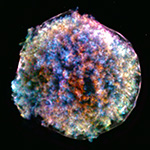
Tycho’s SNR, Year: 1572 A.D.
In 1572, the Danish astronomer Tycho Brahe observed and studied the explosion of a star that became known as Tycho’s supernova. More than four centuries later, Chandra’s image of the supernova remnant shows an expanding bubble of multimil-lion degree debris (green and red) inside a more rapidly mov-ing shell of extremely high-energy electrons (filamentary blue). Stellar debris moving at 6 million miles per hour has created two X-ray emitting shock waves: one moving outward into the interstellar gas, and another moving back into the debris. These shock waves produce sudden, large changes in pressure and temperature, like an extreme version of sonic booms produced by the supersonic motion of airplanes.
Credit: NASA/CXC/Rutgers/J.Warren & J.Hughes et al.
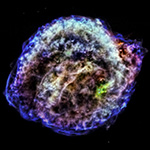
Kepler’s SNR, Year: 1604 A.D.
The “new star” of 1604 AD was reported by astronomers in Europe, China and Korea. At its peak, the brightness of the supernova was greater than that of Jupiter. It is called Kepler’s supernova, because Johannes Kepler determined an accurate position for the supernova and recorded its steady decline in brightness. Chandra’s image of the remnant shows high-energy X-rays (blue) from extremely energetic electrons at the location of a rapidly moving outer shock wave generated by the explo-sion. The interior contains gas heated to millions of degrees by a more slowly moving shock wave. The composition of the hot gas and the absence of a neutron star indicate that Kepler’s supernova was a Type Ia event.
Credit: NASA/CXC/NCSU/S.Reynolds et al.
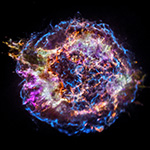
Cassiopeia A, 1680 A.D.
The nature of the explosion that produced the Cassiopeia A (Cas A) supernova remnant is an enigma. The observed expansion of the remnant indicates an age of about 336 years, so the event should have been observed around 1680 AD, yet no reliable reports of the supernova exist. Recent calculations indicate that Cas A was possibly produced by a star that lost much of its mass to a companion star so that a relatively small fraction of its explosion energy was emitted as optical light. In the Chandra image, blue, wispy arcs show where particles are accelerated to extremely high energies by an expanding shock wave generated by the explosion. The red and green regions show material from the destroyed star that has been heated to millions of degrees by more slowly moving shock waves.
Credit: NASA/CXC/MIT/UMass Amherst/M.D.Stage et al.

